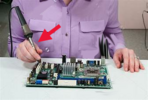-
Categories
-
Platforms
-
Content
Hey there, Speedy Gonzales!#1 you don't need a hot air station. You can use a soldering iron, easier when using two irons, one for each side of the fuse - at least for de-soldering.
#2 before replacing the fuse find the fault that caused the fuse to blow. Otherwise the new fuse will most likely blow immediately at turn-on.
Thank you for your reply. I was thinking maybe it was a temporary surge of current due to an overvoltage. I will try what you explain and intend to replace the varistor as well#1 you don't need a hot air station. You can use a soldering iron, easier when using two irons, one for each side of the fuse - at least for de-soldering.
#2 before replacing the fuse find the fault that caused the fuse to blow. Otherwise the new fuse will most likely blow immediately at turn-on.
Obviously the varistor next to the fuse is blown, too. At least.
I have done a visual inspection but haven't found anything so far, no burning traces, nothing. I'd like to think that there was some surge of current because of a temporary voltage spike...but i Can be wrong.A conventional soldering iron would achieve the same result - I'd use clippers to remove the major parts of the fuse itself to give better access to the copper pads for soldering.
Can't say I agree with the cheapskate fuse installation method...
Have you checked for the reason why the component 'popped'? Could be other faults further in the circuitry.
Thank you, I appreciate your kind contribution. I'm taking notes and i will try to apply all the advice toi have all given me so far.Replacing fuses on a PCB surface without a hot air station can be tricky. It is possible but would require a few extra steps. You will need to be careful when using a soldering iron to remove the fuse as you could damage the board or cause a short. It would be best to use a desoldering braid to remove any solder from the fuse before attempting to remove it. Once the fuse is out, you can then use a soldering iron to attach the new fuse. Make sure you use the correct wattage when soldering. I hope this helps!

